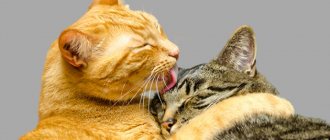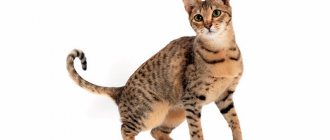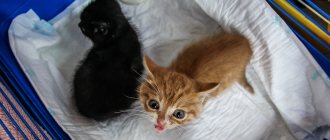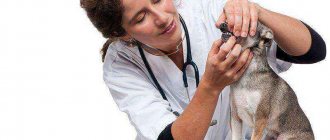How to determine if a rabbit is pregnant
Every pet owner needs to know how to find out if a rabbit is pregnant. There is a general approach that will allow you to verify the presence or absence of pregnancy with a high percentage of reliability.
Young healthy female rabbit with her cubs
First of all, a palpation procedure is required. If an animal is carrying a small number of cubs, then it will be quite difficult to visually determine pregnancy. This is why rabbit owners and veterinarians carefully palpate the abdominal cavity of their pets.
Note! It is possible to feel the cubs in the stomach after two weeks from the moment of conception. If you do not have special skills, then it is strongly not recommended to carry out this procedure yourself, otherwise the fetus may be damaged.
Other important rules:
- You cannot palpate the abdominal cavity of rabbits if more than two weeks have passed from the moment of conception. In this case, the likelihood of damaging the fetus increases significantly;
- the size of the embryo in the vast majority of cases does not exceed the size of a small grape;
- During the examination, the rabbit must be carefully held by the ears and scruff with her right hand. This will completely immobilize the animal during the examination;
- With the left hand, the animal is carefully picked up from below the hind legs in the pelvic area;
- The thumb is again carefully tilted to the right side, and the rest to the left. If the rabbit is pregnant, the embryos developing inside her will be clearly felt.
To ensure that the “diagnosis” is correct, the animal must be shown to a veterinarian.
Pregnancy can also be determined by increasing weight. Like a pregnant woman, as the embryos develop, the female rabbit begins to look different and her appearance changes. On average, the animal during this period gains about 29 g in the first week and about 50 g in the second. No further significant changes are observed.
What do newborn rabbits look like?
For your information! Ultrasound diagnostics (ultrasound) also allows pregnancy to be recognized. Diagnostics can be carried out at the nearest veterinary clinic.
Features of rabbit breeding
For those who breed rabbits and strive to get healthy young animals, it is important to know the specifics of animal reproduction.
It can be difficult to find out that a rabbit is pregnant in the early stages of pregnancy.
What you need to pay attention to:
- Select healthy breeders , without physical defects, sufficient weight and fatness. Obese animals are not allowed to mate, as fertilization will not occur.
- Males and females of the same breed are selected for mating. This is necessary to preserve species advantages: skin color, weight categories. You cannot make pairs between related individuals, as there is a high risk of giving birth to weak rabbits with defects in intrauterine development.
- The age of the rabbits is also important. In young animals, puberty occurs, depending on the breed, at 3.5–4 months, but they have not yet reached physiological maturity. Therefore, mating is carried out when the male is six months old, and the female is 4.5-5 months old.
- The female rabbit comes into heat every 5-10 days , it depends on the time of year and lighting, the duration of estrus is on average 3 days. During this period, she is placed next to the male for mating.
- A young and strong producer, without compromising the quality of sperm, fertilizes 1-2 females every other day. An adult can support up to 4 female rabbits, with the condition that the males are periodically allowed to rest and provided with adequate feeding.
It is better to carry out mating in the male’s territory, so he will not be distracted by irritants; in summer the optimal time is early morning, in winter – mid-day, since heat and cold affect the behavior of animals.
After mating, the female is placed in a cage; the period of control mating is a week later.
The main signs of pregnancy in rabbits
How many times does a mother rabbit feed her babies per day?
How to understand that a rabbit is pregnant? Most often, farmers begin to assume that pregnancy may occur due to changes in the behavior of the animal. In the vast majority of cases, the female rabbit changes her behavior. This method of determination has the advantage of safety, the disadvantage is that the animal may not change its behavior right up to the birth and behave quietly. It may also be possible that there is a false pregnancy.
Important! It is necessary to place the male and female in different cages after intercourse, but not far away so that the animals can see each other. This is due to the fact that rabbits, as a rule, start families.
If, before becoming pregnant, the female was noisy and mischievous, then with the onset of pregnancy, most likely, she will become quiet and cautious. Any items that fall into the cage are used to build the nest and piled up. Another interesting feature is that the animal rolls its fur from its belly and puts it in the nest. She does not allow the male to approach her, and tries to bite the owner if he puts out his hands.
Another characteristic symptom that the female has managed to become covered is that she eats in large quantities and drinks a lot of water. She is rapidly gaining weight and growing on the sides.
Main symptoms of rabbit pregnancy
Note! Of all the listed signs, the most reliable is the rabbit’s desire to build a nest. Construction begins approximately 3-4 days before calving. Wool and hay are used.
How can you tell if an animal is pregnant based on external signs?
Determining the onset of pregnancy, especially in its early stages, is quite a difficult matter. The female can become covered - but not become pregnant.
First of all, the owner of these pets should pay attention to the change in the behavior of the female after mating. The advantages of this technique include its absolute safety for the animal, but there are many more disadvantages. Firstly, the behavior of a fertilized rabbit at the early stage of gestation may not change at all. Young females can even continue to run around and jump almost until they give birth. Secondly, it is very difficult to distinguish a true pregnancy from a false one by external signs. Most often, “empty” females with false pregnancies behave exactly the same as fertilized ones.
Immediately after mating, the female should be taken from the male and placed in a separate cage. However, it is recommended to maintain visual and auditory contact between them, since rabbits are quite friendly family men. Remember - when mating, the female is always placed with the male, and never vice versa. This is due to the fact that the rabbit feels much more confident in its territory and immediately gets down to business.
More on the topic: Peculiarities of breeding breeding rabbits
So how to determine if a rabbit is pregnant?
Usually a lively and playful animal becomes calmer after successful conception.
Her behavior becomes more cautious.
Control mating
Control mating is considered the most effective method.
Since the interval between periods of hunting in female rabbits is approximately a week, 7-8 days after the first mating, she is again placed with the male. If the female avoids sexual contact in every possible way, rushes at the male, begins to bite and squeal, the chance that conception was successful is very high.
The second external sign is the construction of a nest.
As the birth approaches, the expectant mother begins to drag straw and hay into the queen cell (or simply to a secluded place), and also begins to tear the fluff on her chest and abdomen to place it in the place where the future offspring will live. In addition, she becomes aggressive, defends her territory and can even bite her owner. If she is not disturbed, she tries to hide from prying eyes and hides in secluded corners in search of solitude.
Also, a female bearing offspring usually begins to eat much more and drink more, and becomes more picky about food. Gradually its weight increases, and its sides become rounder.
The female usually begins building a nest three to four days before giving birth, and if this happens on the 26-27th day after mating, the process proceeds normally. If the female began building a nest much earlier, most likely her pregnancy is false. However, as with any rule, this also has its exceptions. There are cases when a female rabbit begins to develop a queen cell much earlier, and the pregnancy is true. It also happens the other way around. The female does not try to build a nest at all and gives birth without it.
In any case, having noticed the changes in behavior described above, you should isolate the female rabbit from other animals and try to protect her as much as possible from external stimuli so that the female remains in peace and quiet.
Palpation (palpation method)
This is the second most popular method of determining pregnancy after control mating, however, to use it, the rabbit breeder must have the necessary skills and experience.
If you are a novice farmer, then at first it is not recommended to palpate the rabbit yourself. It is better to first involve a qualified veterinarian or a more experienced breeder in order to eliminate the possibility of injury to future cubs.
In order to master this technique, practice on those females that did not have time to veil, and then compare your sensations after feeling the uterus.
This method is usually used in the third week of pregnancy. To do this, the female is placed with her muzzle towards herself and slightly thrown back on her back. Holding the animal with your left hand, you gently palpate the mother rabbit’s belly with your right hand. It can be done differently. The female rabbit is placed on a flat surface with her head towards you and secured with one hand by the sacrum. With your free hand, carefully feel the stomach, trying to feel the presence of fruits. Usually, future rabbits are located on the sides of the lower part, in the form of a chain.
Igor Nikolaev
auto RU
The uterus of a pregnant female greatly increases in size and fills with fluid. If she begins to tense her abdominal muscles during palpation, it means she is nervous. Stop the procedure and calm the frightened animal. When the rabbit relaxes, you can continue. The fruits feel like small dense ovals, about the size of a plum. Under no circumstances should you squeeze the embryos - the future rabbit may be harmed.
More on the topic: How is rabbit farming carried out on a farm?
The size of future cubs in the womb at a period of two weeks is approximately two centimeters, and at this time they weigh three grams. After another ten days, their weight increases to twenty grams. At the same time (approximately on the 25th day) they begin to move a little. This is a sure sign of imminent childbirth.
The duration of gestation in rabbits varies from 28 to 34 days. This depends on the breed of the animals, as well as on the number of rabbits in the future litter. The more cubs a female carries, the shorter the gestation period. This indicator is also affected by the age of the rabbit.
How long does a female rabbit bear offspring?
Before you start placing a male rabbit with a female rabbit, you need to take care of all things in advance. The fact is that female rabbits do not carry the fetus for long; the duration of this period varies between 28-33 days. Most often, animals give birth at 30-31 days. The first signs of life and movement are observed on days 25-27 of pregnancy.
Why does the rabbit not let the rabbit come and what to do?
As for the time of day, most often the active phase of labor occurs in the morning or evening; rabbits rarely give birth during the day. The duration of labor is no longer than 5-10 minutes, in extreme cases about 1 hour.
It is impossible to understand how many cubs there will be in the end. There are cases where during one pregnancy a rabbit gave birth to 13-15 babies, but most of them are weak and practically non-viable. Most often, no more than 5-8 rabbits are born.
During the year, a female can be covered by males 5-6 times. In total, during the year, each female rabbit can bring up to 30 rabbits.
Note! Animals are capable of conceiving at the age of 12 weeks, but experienced farmers strongly recommend not to cover the female immediately, since in the future this can have an extremely negative impact on her health.
Rabbit mating process
Caring for a rabbit during pregnancy and providing conditions
Why does a mother rabbit eat her newborn rabbits?
With the onset of pregnancy, the female must be separated from the male in different cages. The ideal option is for them to communicate through the network.
Important! A pregnant animal must be protected in every possible way from stressful situations - contact with aggressive animals or noise. Rest, food and water should be provided in virtually unlimited quantities.
If the animal is in no hurry to set up a nest on its own, then closer to birth it definitely needs help. It is necessary to equip a corner in which small cubs can lie. The place is insulated with soft bedding and mother's down.
What to feed a pregnant rabbit
What to feed a pregnant rabbit in winter, spring, summer and autumn? There are no fundamental differences as such, but special attention needs to be paid to feeding. It is important that the diet contains a large amount of vitamins and minerals. If this is neglected, the female may have a miscarriage.
New foods should be introduced gradually into the animal’s diet. Meals should include:
- parsley;
- carrots;
- tomatoes;
- celery;
- hay;
- cucumbers;
- high quality granulated industrial feed;
- lettuce
Hay should not be just grass; it is better to give preference to dried alfalfa.
Diet of a pregnant rabbit
Every day the animal will need more and more food, so the listed ingredients should be fed to the pet daily.
Before giving birth, the amount of food is gradually reduced. Approximately 2 days before the upcoming birth, the amount of food is reduced by almost 2 times. This approach makes it possible to prevent the development of ketosis or mastitis in the female in the near future.
Note! After birth, the amount of feed is gradually increased, returning to the previous level.
How to find out if a rabbit is pregnant
In the early stages, it is difficult to understand that conception has occurred, but there are methods for detecting pregnancy.
A 100% reliable method is ultrasound , which allows you to control fertilization within 6 days after coating.
Ultrasound is the best method for determining pregnancy, which gives 100% accurate results already on the sixth day after mating
But the method is not always available; carrying out the procedure in a veterinary clinic is complicated by transportation, a large number of females, especially in large farms.
Therefore, rabbit breeders focus on the following methods:
- analysis of external changes and behavior;
- palpation;
- replanting with a male.
As pregnancy progresses, the female’s weight also changes due to the growth of embryos and an increase in the mass of the fertilized uterus. For diagnosis, it is necessary to weigh the animal before mating.
Checking the rabbit's weight
Approximately the weight should increase:
- after 7 days – by 29 g;
- after 14 days - at 59
The diagnostic method cannot be considered reliable, since the female also gains weight due to eating more food.
Palpation procedure
Checking for pregnancy by palpating the rabbit's abdomen gives an accurate idea of the presence of embryos in the uterus. Caution is important here.
Palpation procedure for a female rabbit
It is recommended that experienced rabbit breeders perform these manipulations so as not to frighten the animal and cause miscarriage. If you don’t have enough experience, it’s better not to take risks and call a veterinarian.
The examination is carried out on the 14-16th day after mating.
How the procedure is carried out:
- The female is placed on a horizontal surface: a table or a wide bench.
- Hold the scruff of the neck with your hand to ensure its immobility.
- The other hand is placed under the stomach in the pelvic area and carefully palpated.
The fingers feel the compacted area of the pregnant uterus; small oval seals the size of a hazelnut are found in its horns. These are developing embryos.
Attention! When palpating, it is important not to confuse the embryos with lumps of feces: the latter feel harder and smaller to the touch.
By external signs
In the early stages, the appearance of a pregnant rabbit does not change, young animals are playful , eat well and jump, sometimes this behavior persists until childbirth.
After a week, depending on their temperament and character, the females become calmer, more careful, or, conversely, active and irritable. Some are so aggressive that they bite the owner when trying to pet the animal.
The female's belly is noticeable from the 3rd week of pregnancy , she moves more slowly, may show dissatisfaction or hide in the nest when approaching the cage.
Aggression towards the male
A common and simple way to determine conception is by implantation with a male . A single female rabbit will not resist communication; during the period of estrus she will allow mating.
If the female is older than two or three years, the chance of pregnancy is minimal - she is already too old to bear offspring
The pregnant woman will not accept courtship, will not allow the rabbit to come close to her, and will behave aggressively: snort and kick with her hind legs.
Nesting
A typical manifestation of pregnancy and imminent birth is the construction of a nest 3-4 days before giving birth. The female is worried, carries hay and straw into the nest, pulls out fur from her belly and chest, and tries to dig at the bottom of the cage.
If she is kept with other rabbits, she will attack them when relatives approach the nest.
Changing eating behavior
During pregnancy, the attitude towards food changes: females eat and drink more. If they do not like the food offered, they scatter it around the cage or actively consume those foods that they had previously refused.
False pregnancy
There is also such a thing as a false pregnancy in a rabbit. False pregnancy is almost completely identical in characteristics to the real one, despite the fact that fertilization never occurred. The duration of this period is about 2 weeks.
The main reasons for the development of false pregnancy in an uncovered female:
- diseases or pathologies of the development of organs of the female reproductive system;
- external stimuli, for example, the length of daylight in the warm season;
- hormonal imbalance;
- mating with a castrated male.
During a false pregnancy, the body produces follicles under the influence of hormones. This phenomenon can be recognized by the behavior of the female - she is aggressive, there is a complete or partial loss of appetite. The animal is hyperactive and nervous, but after a few days the symptoms gradually disappear.
The appearance of the nest that the female rabbit prepares before giving birth
If false pregnancy occurs frequently, the animal must be shown to a veterinarian so that he can conduct an examination and take all the necessary tests. Once the diagnosis is made, treatment should begin immediately.
Note! To prevent the development of such anomalies, it is recommended to regularly introduce sage, fennel, lemon balm and basil into the diet of females. These plants have a pronounced calming effect.











